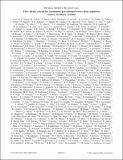First all-sky search for continuous gravitational waves from unknown sources in binary systems
Author(s)
Barsotti, Lisa; Biscans, Sebastien; Bodiya, Timothy Paul; Donovan, Frederick J.; Essick, Reed Clasey; Evans, M.; Fritschel, Peter K.; Gras, Slawek; Isogai, Tomoki; Katsavounidis, Erotokritos; Kwee, Patrick; Lee, J.; Libson, Adam; Lynch, Ryan Christopher; MacInnis, Myron E.; Mason, Kenneth R.; Matichard, Fabrice; Mavalvala, Nergis; Miller, John; Mittleman, Richard K.; Oelker, Eric Glenn; Shoemaker, David H.; Tse, Maggie; Vaulin, Ruslan; Vitale, Salvatore; Weiss, Rainer; Wipf, C. C.; Zhang, Fan; Zucker, Michael E.; Aggarwal, Nancy,Ph. D.Massachusetts Institute of Technology.; ... Show more Show less
DownloadAasi-2014-First all-sky search.pdf (839.9Kb)
PUBLISHER_POLICY
Publisher Policy
Article is made available in accordance with the publisher's policy and may be subject to US copyright law. Please refer to the publisher's site for terms of use.
Terms of use
Metadata
Show full item recordAbstract
We present the first results of an all-sky search for continuous gravitational waves from unknown spinning neutron stars in binary systems using LIGO and Virgo data. Using a specially developed analysis program, the TwoSpect algorithm, the search was carried out on data from the sixth LIGO science run and the second and third Virgo science runs. The search covers a range of frequencies from 20 Hz to 520 Hz, a range of orbital periods from 2 to ∼2,254 h and a frequency- and period-dependent range of frequency modulation depths from 0.277 to 100 mHz. This corresponds to a range of projected semimajor axes of the orbit from ∼0.6 × 10[superscript −3] ls to ∼6,500 ls assuming the orbit of the binary is circular. While no plausible candidate gravitational wave events survive the pipeline, upper limits are set on the analyzed data. The most sensitive 95% confidence upper limit obtained on gravitational wave strain is 2.3 × 10[superscript −24] at 217 Hz, assuming the source waves are circularly polarized. Although this search has been optimized for circular binary orbits, the upper limits obtained remain valid for orbital eccentricities as large as 0.9. In addition, upper limits are placed on continuous gravitational wave emission from the low-mass x-ray binary Scorpius X-1 between 20 Hz and 57.25 Hz.
Date issued
2014-09Department
Massachusetts Institute of Technology. Department of Physics; MIT Kavli Institute for Astrophysics and Space ResearchJournal
Physical Review D
Publisher
American Physical Society
Citation
Aasi, J., B. P. Abbott, R. Abbott, T. Abbott, M. R. Abernathy, T. Accadia, F. Acernese, et al. “First All-Sky Search for Continuous Gravitational Waves from Unknown Sources in Binary Systems.” Phys. Rev. D 90, no. 6 (September 2014). © 2014 American Physical Society
Version: Final published version
ISSN
1550-7998
1550-2368